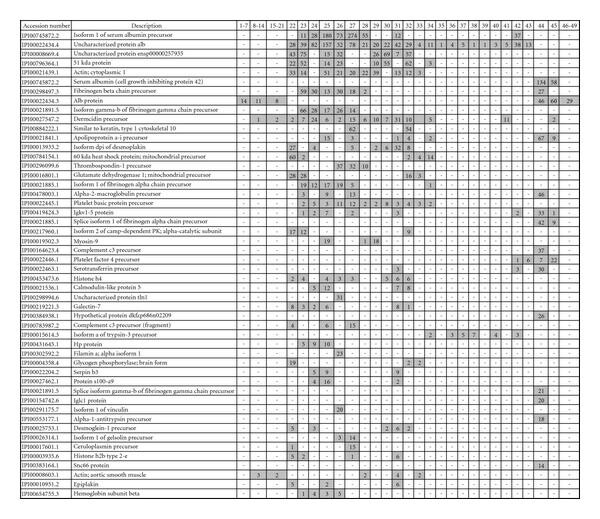Proteomics Strategy for Identifying Candidate Bioactive Proteins in Complex Mixtures: Application to the Platelet Releasate
Abstract
Proteomic approaches have proven powerful at identifying large numbers of proteins, but there are fewer reports of functional characterization of proteins in biological tissues. Here, we describe an experimental approach that fractionates proteins released from human platelets, linking bioassay activity to identity. We used consecutive orthogonal separation platforms to ensure sensitive detection: (a) ion-exchange of intact proteins, (b) SDS-PAGE separation of ion-exchange fractions and (c) HPLC separation of tryptic digests coupled to electrospray tandem mass spectrometry. Migration of THP-1 monocytes in response to complete or fractionated platelet releasate was assessed and located to just one of the forty-nine ion-exchange fractions. Over 300 proteins were identified in the releasate, with a wide range of annotated biophysical and biochemical properties, in particular platelet activation, adhesion, and wound healing. The presence of PEDF and involucrin, two proteins not previously reported in platelet releasate, was confirmed by western blotting. Proteins identified within the fraction with monocyte promigratory activity and not in other inactive fractions included vimentin, PEDF, and TIMP-1. We conclude that this analytical platform is effective for the characterization of complex bioactive samples.
1. Introduction
Platelets are anucleate cells that are important for haemostasis, thrombosis, and atherosclerotic disease. A number of bleeding disorders arise as a result of mutations in the genes for proteins involved in platelet aggregation. Thus, altered or deregulated platelet function underpins many diseases, and platelet proteins are potential targets for novel therapeutic agents. Previous proteomic studies of intact platelets have collectively identified hundreds of proteins using a variety of fractionation strategies including 2-dimensional electrophoresis (2DE), multidimensional chromatographic separations, membrane prefractionation techniques, and adsorption to combinatorial hexapeptide ligand libraries [1–6]. Following activation by agonists such as thrombin, platelets release storage granules and membrane vesicles that contain prothrombotic (e.g., fibrinogen), mitogenic (e.g., platelet derived growth factor), immunomodulatory (e.g., neutrophil-activating peptide 2), and adhesive (e.g., platelet endothelial cell adhesion molecule) proteins. A previous study from our laboratory using a MuDPIT (multidimensional protein identification technology) approach identified over 300 proteins secreted by platelets upon thrombin activation [1]. These proteins may modulate the interaction of platelets with their local cellular environment. Indeed, platelet releasate has previously been shown to induce endothelial cell permeability, endothelial cell chemotaxis, and corneal epithelial cell proliferation in cellular assays [7–9].
The issue of abundant (often housekeeping) proteins masking regulatory proteins of lower abundance (such as signaling proteins and cytokines) continues to be a challenging issue for proteomics particularly in the case of biofluids. Plasma has a significant dynamic range, with more than 10 orders of magnitude separating albumin concentration and the rarest measurable proteins identified to date [10]. Protein and peptide chromatography prior to MS analysis can partly address this issue. The classical example of this is MuDPIT, first described by Andrew Link and colleagues [11]. In the first dimension, ion-exchange chromatography (IEC) separates peptides based on ionic interactions with the solid phase and an increasing salt buffer. This is coupled to RP-HPLC to create a second dimension of separation prior to MS analysis. Complex biological samples have also been successfully separated in multiple dimensions at the protein level. For instance, a number of studies have used 1D SDS-PAGE to separate proteins by molecular weight prior to MS analysis [12–15].
While modern proteomics experiments permit the analysis of hundreds to thousands of proteins in complex samples, the most powerful use of this data would combine information on protein activity with the identities of the active proteins. The emerging field of chemical proteomics [16] addresses this question elegantly for an increasing number of enzymatic functions through formation of covalent enzyme-substrate conjugates [17]. However, many higher-level cellular functions encompassing multiple steps are not amenable to these approaches. A limited number of studies involving proteomic fractionation combined with biological assay and subsequent MS identification of active proteins have been reported [18–20]. Here we use IEC to separate the platelet releasate for subsequent assay of monocyte migratory activity. IEC relies on electrostatic interactions between the proteins and the chromatography matrix, so that fractionation primarily depends on net protein charge. We chose a scheme, incorporating both cation and anion resins, in preference to a size-based fractionation scheme because many secreted proteins are small (<20 KDa) and so would cofractionate. We further separated the IEC fractions by SDS-PAGE, carrying out multiple (~30) LCMS runs per IEC fraction, thus ensuring extensive coverage of the platelet releasate proteome. By correlating the presence of proteins in active fractions (and conversely by discounting the contribution of proteins detected in inactive fractions), a more focused list of active proteins could be obtained compared to those obtained from conventional proteomics approaches.
2. Methods
2.1. Preparation of Platelet Releasate
Plasma and washed platelet samples were prepared from 100 mL of blood drawn from healthy human volunteers free from analgesic medication for 10 days using a modification of the method described by Mendelsohn [21]. Following centrifugation of blood for 10 minutes at 150 g, platelet-rich plasma (PRP) was harvested. Platelets were pelleted by centrifugation at 720 g for 10 minutes and subsequently resuspended in a modified HEPES buffer (JNL buffer) (130 mM NaCl, 10 mM trisodium citrate, 9 mM NaHCO3, 6 mM dextrose, 0.9 mM MgCl2, 0.81 mM KH2PO4, 10 mM Tris pH 7.4) at a concentration of 2 × 109 platelets/mL or 2 × 108 platelets/mL.
Platelet suspensions were supplemented with 1.8 mM CaCl2, incubated at 37°C in an aggregometer under constant stirring conditions (1100 rev/min), and stimulated with 5 μM thrombin receptor-activating peptide (TRAP) for 3 minutes. Platelet releasate was isolated as previously described [1]. Briefly, platelets were removed from the releasate by two sequential centrifugal spins at 750 g, protease inhibitor cocktail (Merck Biosciences, UK) was added, and releasate samples were stored at −20°C.
2.2. Ion-Exchange Chromatography
Platelet releasate samples (from 2 × 109 platelets/mL preparations) were desalted using Zeba spin columns (Pierce, Rockford, Illinois) as per manufacturer instructions prior to ion-exchange chromatography (IEC) fractionation. Subsequently, 0.75 mL of desalted platelet releasate was injected onto ProPac anion and cation-exchange columns (Dionex, UK) configured in series on the Ultimate TM 3000 LC system (Dionex, UK). The flow rate was set at 200 μL/min and fractions were collected every minute into a 96-well plate. A UV detector (wavelength of 280 nm) was used to identify eluting peptides. After an initial 10-minutes equilibration, a gradient of 0.02 M–0.5 M salt was delivered to the columns by appropriate mixing of IEC buffer A (20 mM K2HPO4 pH 9.0) and IEC buffer B (20 mM K2HPO4 pH 9.0, 1 M NaCl) over a time course of 25-minutes. This was followed by a 5-minute wash with IEC buffer B (“clean off”) and 5-minute equilibration with IEC buffer A.
2.3. Cell Culture and Migration Assay
A monocytic leukaemia cell line, THP-1, was obtained from EACC (Salisbury, UK). Cells were grown in RPMI 1640 medium, supplemented with 10% FBS, 2 mM/L L-glutamine, 100 U/mL penicillin, and 100 μg/mL streptomycin. The cells were passaged every 5–7 days. All cells were maintained as a suspension culture at 37°C in 5% CO2/95% ambient air. THP-1 migration was measured using a Boyden chamber assay. THP-1 cells were centrifuged at 1000 g and resuspended in serum-free media (SFM) at a concentration of 1 × 106 cells/mL. Of this cell suspension, 100 μL was added to the upper chamber of an 8 μm pore-size transwell (Corning BV, Schiphol-Rijk, The Netherlands). For the purpose of the migration assay, 2 μL of three successive IEC fractions (from 1–49) were pooled and added to the lower chamber. SFM was added to a final volume of 1 mL. A positive control of 10% FBS in SFM was used. The transwell inserts were placed into the lower chamber and incubated for 2 hours at 37°C in 5% CO2/95% ambient air. The number of two populations of cells migrating to the bottom chamber was assessed, the cells migrating to the bottom chamber and adhering to the membrane and the cells migrating to the bottom chamber without adhering to the membrane. Nonmigrating cells on the upper surface of the membrane were removed by gentle scraping with a cotton bud and adherent migratory cells on the lower surface of the membrane were counted following fixation with 2.5% glutaraldehyde for 20 minutes and staining for 1 hour with crystal violet stain. The number of cells migrating and adhering to the underside of the membrane was evaluated by counting ten random non overlapping 40X fields. To assess the number of cells which migrated through the membrane but did not adhere to the membrane, the media in the lower chamber was collected and centrifuged at 1000 g. The cell pellet was resuspended in 16 μL PBS, 4 μL trypan blue was added, and the cells were counted using a hemocytometer.
2.4. Visualisation of Fractionated Proteins
Protein from IEC fractions was methanol/chloroform precipitated [22] and separated using 4%–20% acrylamide gradient gels (Pierce, Rockford, Illinois) [23]. Protein gels were silver stained using a SilverSnap kit (Pierce, Rockford, Illinois).
2.5. LC-MS/MS (Liquid Chromatography-Tandem Mass Spectrometry)
SDS-PAGE gel lanes were cut into 32 bands and digested in-gel with sequencing grade trypsin (Promega, Ireland) according to the method of Shevchenko et al. [15]. The resulting peptide mixtures were resuspended in 0.1% formic acid and analysed by nanoelectrospray liquid chromatography mass spectrometry (Nano-LC MS/MS). An HPLC instrument (Dionex, UK) was interfaced with an LTQ ion trap mass spectrometer (ThermoFinnigan, CA). Chromatography buffer solutions (“Buffer A”, 5% acetonitrile and 0.1% formic acid; “Buffer B”, 80% acetonitrile and 0.1% formic acid) were used to deliver a 60-minute gradient (35 minutes to 45% Buffer B, 10 minutes to 90%, hold for 10 minutes, 3 minutes to 5%, hold for 15 minutes). A flow rate of 2 μL/min was used at the electrospray source. Spectra were searched using the SEQUEST algorithm against the International Protein Index (IPI) database (http://www.ebi.ac.uk/IPI/IPIhelp.html), as described previously [24]. The probability-based evaluation program, Protein Prophet, was used for filtering identifications [25].
2.6. Bioinformatic Analysis
Ontological analysis of protein identifications was performed using the GOTM website (http://babelomics2.bioinfo.cipf.es/) [26]. A hypergeometric test corrected for multiple testing (Bonferroni) was used to determine statistically significant enrichments (P < .01). To analyse the range of proteins identified in this study, the predicted molecular weight and isoelectric point of each protein were obtained using the Compute pL/MW tool from the ExPASy server (http://expasy.org/).
2.7. Western Blot
Western blot was carried out as previously described [27] with the following modifications. Equal volumes of resting and TRAP-stimulated platelet releasates were loaded into each well and separated on a 4%–20% acrylamide gradient gel. The primary antibody for the detection of PEDF was a rabbit polyclonal antibody (1 in 1000 dilution overnight at 4°C) from Upstate Cell Signaling Solutions (Buckingham, UK). The primary antibody for the detection of involucrin was a mouse monoclonal antibody (1 in 200 dilution overnight at 4°C) from Sigma (Dublin, Ireland). Anti-mouse and anti-rabbit secondary horseradish peroxidase (HRP) conjugated antibodies were obtained from Cell Signaling Technology (Danvers, MA). Peroxidase activity was detected using luminol chemiluminescent substrate from Santa Cruz Biotechnology, Inc. (Santa Cruz, CA).
3. Results
3.1. Strategy for Linking Biological Activities to Individual Tissue Fractions
The overall strategy is shown in Figure 1. We used ion-exchange chromatography (IEC) to separate a complex protein mixture, proteins secreted by human platelets in response to the agonist thrombin receptor-activating peptide (TRAP), into fractions suitable for both biological analysis and identification by mass spectrometry. While strategies such as MuDPIT separate at the level of the tryptic peptide; separation at the protein level reduces sample complexity and facilitates correlation of the presence (or absence) of a protein with an observed biological function. The effect of platelet releasate on THP-1 monocyte migration was investigated to test this strategy. Addition of serum to media in the bottom of the Boyden chamber indeed stimulated migration of monocytes (data not shown), although interestingly serum stimulation did not cause the cells to adhere to the underside of the Boyden chamber membrane (Figure 2(a)). In contrast, both MCP-1 (a well-known pro-migratory chemokine for monocytes) and platelet releasate induced monocyte migration simultaneously caused these suspended cells to adhere to the underside of the membrane (Figure 2(a)). The effect of releasate was dose dependent (Figure 2(b)).
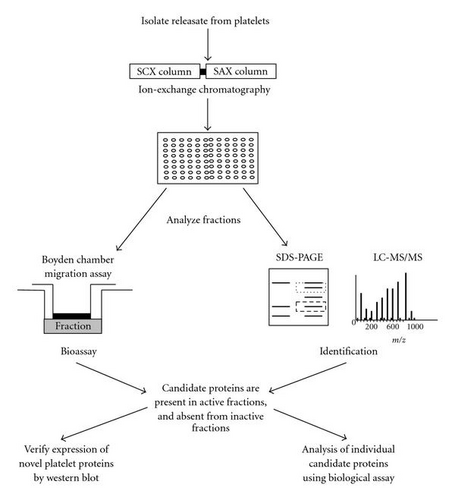
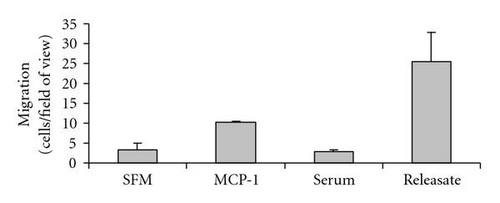
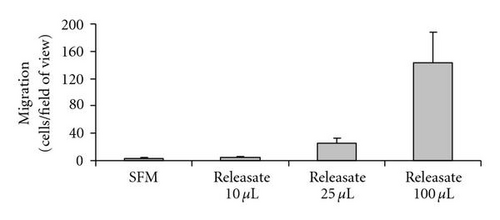

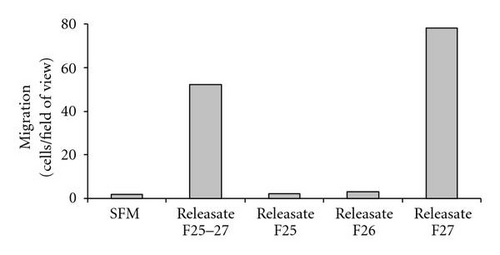
To identify releasate fractions with biological activity, consecutive IEC fractions were initially pooled in groups of three for the analysis of THP-1 migration. One pooled fraction, 25–27, was found to strongly induce monocyte migration (Figure 2(c)). We repeated the assay using the individual fractions 25, 26, and 27. In this second experiment, the pro-migratory activity could be localized to fraction 27 (Figure 2(d)). Data displayed in Figure 2 describes “adherent migration”, that is, cells which migrated through the 8 μm pores and adhered to the underside of the membrane. In order to identify the proteins present in each fraction, each lane from the SDS-PAGE gels of fractionated platelet releasate (Figure 3(a)) was divided into 32 bands, digested with trypsin, and subjected to LC-MS/MS, and the corresponding proteins were identified by database search (Supplementary Table 1 in supplementary material available online at doi: 10.1155/2010/107859). For each fraction, spectral counts (counts of tandem mass spectrometry events leading to productive protein identification), an approximate indicator of protein abundance, were calculated, and the total spectral count for all proteins in the fractions was determined (Supplementary Table 2). The top fifty proteins by spectral counts are displayed in Table 1. The spectral counts (Figure 3(b)) and number of proteins identified (Figure 3(c)) correlate with each other, and also with the staining patterns of the proteins on the gels (Figure 3(a)). Of the 315 proteins identified, 220 were found in a unique fractions (70%), suggesting effective IEC separation (Figure 3(d)). Abundant proteins were often found in adjacent fractions, for example, thrombospondin was most abundant in Fraction 26 but also identified in Fractions 27 and 28. Some proteins were identified in nonadjacent fractions, perhaps reflecting differential migration of protein isoforms (e.g., splicing, proteolytic cleavage, and posttranslational modification).
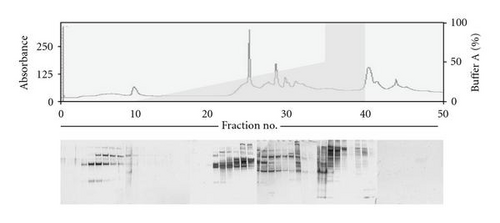
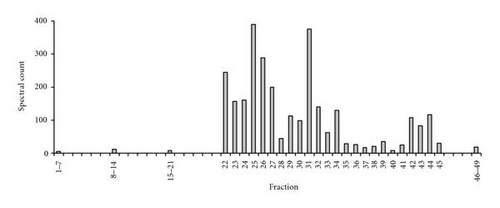
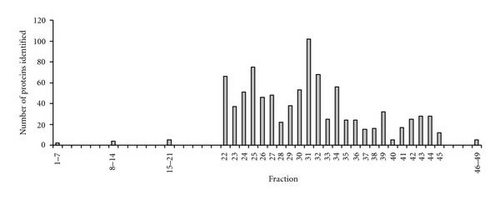

3.2. Biological and Biophysical Properties of Fractionated Platelet Releasate
Our analysis resulted in the high confidence identification of 315 proteins and represents an extensive proteomic coverage of platelet releasate. The identified proteins demonstrated an extensive array of annotated biophysical properties as are evidenced by the wide range of PI and molecular weights predicted for the identifications (Figure 4(b)), suggesting that the method introduced no strong bias against any category of protein. Similarly, proteins with a wide range of annotated activities were identified. The frequency of different functional annotations within the released platelet proteins was compared to the expected frequency based on all human proteins annotated in the Gene Ontology (GO) database using the GOTM program [26]. Hemostasis, blood coagulation, and wound healing were identified as being overrepresented biological processes, as well as molecular functions such as actin binding, protein binding, and calcium ion binding (P<.01) (Figure 4(a)). GO levels between 2 and 5 were used to avoid overgeneral and overspecific functions. Many of these enriched functions appear to be relevant to potential endocrine platelet functions, for instance, “hemostasis”, “wound healing”, and “coagulation”, while others may be relevant to the platelet activation response (“platelet activation”, “localization”, “purine nucleotide binding”, and “calcium binding”).
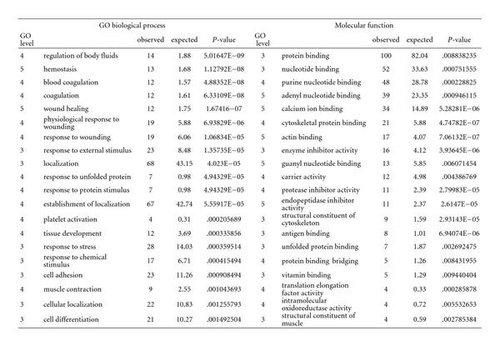
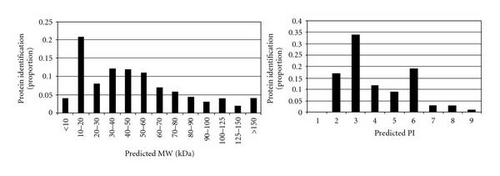
3.3. Investigation of Active Fraction
Thirty-two proteins were found in Fraction 27, the only fraction that stimulated monocyte migration (Table 2). Of these proteins, six were not found in any other fraction in our study. These proteins included tissue inhibitor of metalloproteinase 1 (TIMP-1), vimentin, and pigment epithelium-derived growth factor (PEDF). Spectral counts, functions, and information on their identification in other fractions are listed for all fraction 27 proteins in Table 2. The bold areas highlight those proteins that are only found in Fraction 27. The identified proteins were compared to datasets from previous studies of platelet proteins to determine whether the identified proteins had been previously identified in platelets [1, 2, 5, 6, 27–31]. The presence of two novel platelet proteins, PEDF and involucrin (see Supplementary Table 1 for full details), was confirmed by immunoblotting (Figure 5). PEDF was identified at the expected mass of approximately 50 kDa in platelet releasate preparations with additional heavier bands also detected (Figure 5(a)). Previous studies have identified PEDF at 50 kDa with additional bands at 66 kDa and 76 kDa in Y79 cell lysates using this antibody. PEDF was found to a greater extent in TRAP-stimulated platelet releasate compared to resting/unstimulated releasate. The highest band (76 kDa) was also present in the resting releasate from four different individual donors. Involucrin was identified in TRAP-stimulated platelet releasates at a mass of approximately 120 kDa (Figure 5(b)).
| IPI no. | Protein name | Spectral count | Other fractions where protein was found | Description | Previously found in platelets |
|---|---|---|---|---|---|
| IPI00745872.2 | Isoform 1 of serum albumin precursor | 274 | 23–26, 28, 31, 42 | Serum albumin | Yes |
| IPI00022434.4 | Uncharacterized protein alb | 78 | 22–26, 28–43, | Albumin protein | Yes |
| IPI00021439.1 | Actin, cytoplasmic 1 | 20 | 22-23, 25-26, 28–29, 31–33 | Highly conserved cytoskeletal protein involved in cell motility | Yes |
| IPI00298497.3 | Fibrinogen beta chain, precursor | 18 | 23–26, 28, 44 | Yields monomers that polymerize fibrin and act as a cofactor in platelet aggregation | Yes |
| IPI00021891.5 | Isoform gamma-b of fibrinogen gamma chain precursor | 14 | 23–26 | Yields monomers that polymerize fibrin and act as a cofactor in platelet aggregation | Yes |
| IPI00027547.2 | Dermcidin precursor | 15 | 8–26, 28–32, 34, 41, 45 | Antimicrobial activity and survival promoting peptide for neurons | |
| IPI00884222.1 | Similar to keratin, type 1 cytoskeletal 10 | 62 | 32 | Heterotetramer of two type I and two type II keratins | |
| IPI00021841.1 | Apolipoprotein a-i precursor | 3 | 25, 31-32, 34, 44–45 | Participates in reverse transport of cholesterol from tissues to the liver | |
| IPI00013933.2 | Isoform dpi of desmoplakin | 5 | 22, 24, 29–32 | High molecular weight protein of desmosomes | |
| IPI00296099.6 | Thrombospondin-1 precursor | 32 | 26, 28 | Adhesive glycoprotein that mediates cell-to-cell and cell-to-matrix interactions | Yes |
| IPI00021885.1 | Isoform 1 of fibrinogen alpha chain precursor | 5 | 23–26, 34 | Cofactor in platelet aggregation and yield monomers that polymerize into fibrin | Yes |
| IPI00478003.1 | Alpha-2-macroglobulin precursor | 13 | 23, 25, 44 | Protease inhibitor | |
| IPI00022445.1 | Platelet basic protein precursor | 12 | 23–26, 28–34 | Precursor for a number of peptides with antimicrobial (TC-1 and TC-2), chemoattractant, and stimulation of DNA synthesis activity | Yes |
| IPI00419424.3 | Igkv1-5 protein | 2 | 23–25, 31, 42, 44–45 | Immunoglobulin | |
| IPI00453473.6 | Histone h4 | 3 | 22-23, 25-26, 30–32, 34, 36 | Core component of nucleosomes playing a central role in DNA repair, replication, and transcription | |
| IPI00783987.2 | Complement c3 precursor (fragment) | 15 | 22, 25 | Involved in activation of the complement system and local inflammation | |
| IPI00026314.1 | Isoform 1 of gelsolin precursor | 14 | 26 | Calcium-regulated, actin-modulating protein | Yes |
| IPI00022434.4 | Uncharacterized protein alb. | 78 | 22–26, 28–43 | Uncharacterized albumin protein | Yes |
| IPI00017601.1 | Ceruloplasmin precursor | 15 | 22 | Glycoprotein involved in iron transport across cell membrane | |
| IPI00382606.1 | Factor vii active site mutant immunoconjugate | 4 | 45 | Initiates extrinsic pathway of blood coagulation | |
| IPI00154742.6 | Igl@ protein | 2 | 24-25, 31 | Immunoglobulin | |
| IPI00550991.3 | Alpha-1-antichymotrypsin precursor | 6 | 44 | Inhibits neutrophil cathepsin G and mast cell chymase | |
| IPI00025252.1 | Protein disulfide-isomerase a3 precursor | 4 | 26 | Catalyses the rearrangement of S-S bonds in proteins | Yes |
| IPI00022431.1 | Alpha-2-hs-glycoprotein precursor | 3 | 44 | Secreted protein, part of the fetuin family, may be involved in differentiation | Yes |
| IPI00032292.1 | Metalloproteinase inhibitor 1 precursor | 3 | Complexes with metalloproteinases and irreversibly inactivates them | Yes | |
| IPI00555812.4 | Vitamin d-binding protein precursor | 1 | 23, 44 | Multifunctional protein found in many body fluids and on the surface of various cell types | Yes |
| IPI00179709.4 | Isoform 1 of tubulin alpha-3c/d chain | 2 | Major constituent of microtubules | ||
| IPI00006114.4 | Proliferation-inducing protein 35/PEDF | 2 | Induces neuronal differentiation and inhibits angiogenesis | Yes | |
| IPI00739464.1 | Similar to cytoplasmic beta-actin | 1 | 31 | Highly conserved cytoskeletal protein involved in cell motility | Yes |
| IPI00414860.6 | 60s ribosomal protein l37a | 1 | Ribosomal protein containing a zinc finger domain, expressed in many cell types | Yes | |
| IPI00020996.3 | Insulin-like growth factor-binding protein complex acid labile chain precursor | 1 | Secreted protein involved in protein complexes with insulin-like growth factor family | ||
| IPI00418471.6 | Vimentin | 1 | Class III intermediate filament protein found in many nonepithelial cells | Yes |
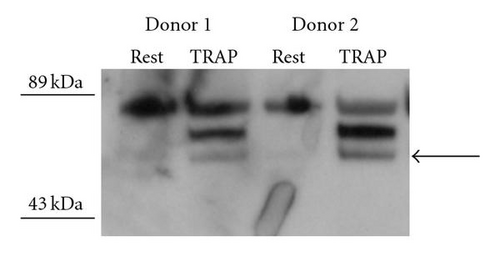
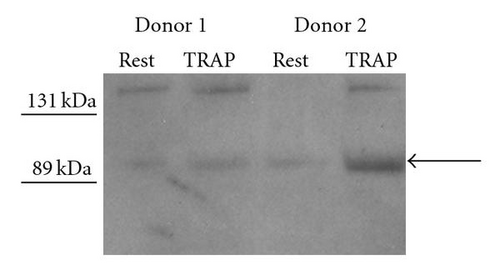
4. Discussion
One aim of proteomics is to address biological questions through the identification and characterization of proteins en mass. In this study, we developed an approach to separate a complex biological mixture using orthogonal separation methods. At the protein level, we used IEC followed by SDS-PAGE, while at the peptide level, reverse phase chromatography preceded MS analysis. We successfully applied protein fractions separated by IEC to a biological assay of monocyte cell migration. The denaturing conditions of gel-based protein separation largely preclude subsequent functional analysis of the proteins. However, a recently developed nondenaturing 2DE method used for the analysis of the Shewanella oneidensis microbial proteome may have applications for functional analysis of separated protein mixtures in the future [32]. The enzymatic activity of malate dehydrogenases from this bacterium was retained and identified within the polyacrylamide gel following 2DE [32].
In total, 315 unique proteins were identified in this analysis of platelet releasate. Proteins which we have previously identified such as fibrinogen, albumin, thrombospondin, haemoglobin, platelet factor 4, platelet basic protein, and actin binding proteins were well represented [1]. While it cannot be discounted that some of these proteins may be residual serum proteins or proteins derived from cellular debris, the identifications detailed in this study are in agreement with previous publications from our laboratory and further afield (see [1, 2, 4, 27, 33–36]).
We also report the identification of proteins which have previously been implicated in neuronal exocytosis such as calmodulin-like protein 3 in Fraction 25 [37] and pleckstrin and sec7 domain protein in Fractions 22 and 26, respectively, [38]. Pigment epithelium-derived factor (PEDF) was also identified in the platelet releasate by mass spectrometric methods and its presence was validated by western blot. PEDF is a potent inhibitor of angiogenesis in the eye [39] and has also been detected in plasma and serum [40, 41]. Interestingly, a recent study suggests that pro- and anti-angiogenic proteins within the platelet may be separated into distinct subsets of alpha granules which are differentially released depending on the agonist [42]. We also confirmed the presence of involucrin, a protein found as a component of scaffolding in the cell envelope of stratified epithelium, in the platelet releasate by western blotting. This protein has not been previously identified in nonepithelial cell types to the best of our knowledge.
Previous studies in our laboratory established that the platelet releasate had a much greater pro-migratory effect on THP-1 monocytes than on human arterial smooth muscle cells or human retinal endothelial cells (data not shown). The use of ion-exchange fractionation enabled us to locate the pro-migratory activity of the platelet releasate to just one of 49 Fractions. Candidate proteins which may be responsible for the monocyte pro-migratory activity of Fraction 27 include tissue inhibitor of metalloproteinase 1 (TIMP-1) and proliferation-inducing protein 35 (PEDF). Future studies will focus on identifying the potential pro-migratory protein, or proteins, in Fraction 27 by using neutralizing antibodies in our cell-based assay, against some of the identified proteins. A decrease in the biological activity of the candidate protein due to the presence of a neutralizing antibody would further support its pro-migratory effect in our cell assay.
However it is also possible, despite the extensive protein separation methods used, that the protein responsible for the migratory activity is a small protein of low abundance which may never be captured by mass spectrometry. Antibody arrays of growth factors and cytokines may also assist in the identification of the pro-migratory protein secreted by platelets. Using this technology we have previously shown that PDGF, angiogenin, RANTES, and many other cytokines and growth factors are secreted by platelets following thrombin activation [27]. These proteins were not identified in any fraction in the current mass spectrometric study of the platelet releasate. Investigation of the contribution of some likely pro-migratory cytokine candidates within the platelet releasate has ruled out certain proteins in terms of monocyte migration. Anti-RANTES neutralizing antibodies had no effect on platelet releasate-induced THP-1 monocyte migration (data not shown). It seems unlikely that MCP-1 is the chemokine responsible for platelet releasate-induced THP-1 migration because 100 ng/mL MCP-1 induced a much lower level of THP-1 migration than TRAP-stimulated platelet releasate.
Both collagen I and collagen IV were identified in Fraction 27 but not in any other fraction, and previous studies in our laboratory have shown a pro-migratory effect of collagen I on arterial smooth muscle cells, so we also investigated the effect of these extracellular matrix proteins on THP-1 migration. However, no evidence of a pro-migratory effect was observed (data not shown). In addition, the possibility that a group of proteins rather than an individual protein in Fraction 27 contributed to the pro-migratory effect can not be discounted without further investigation.
In summary, the approach outlined in the current study facilitated the penetration of the platelet releasate proteome to a sufficient degree to increase the number of low-abundance identifications. This in turn highlighted candidate proteins responsible for platelet releasate induced monocyte cell migration which merit further targeted functional analysis. The method described here could be equally applied to other secretory systems and biological situations involving the functional analysis of secreted proteins from one cell type on another cell function.
Acknowledgments
The authors thank anonymous reviewers for helpful suggestions and the Mass Spectrometry Resource at the UCD Conway Institute. This study was funded by Science Foundation of Ireland and the National Council for the Blind of Ireland. The first and the second authors contributed equally to this manuscript.



